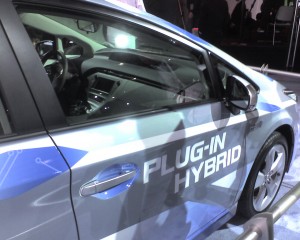Toyota Prius PHV Fights Chevy Volt
As the world leader in hybrid cars, Toyota is fighting to extend that leadership in both plug-in hybrids and battery electric cars. In plug-in hybrids, GM plans on first mover advantage with the Chevy Volt. In electric cars, the Nissan LEAF has a sizable lead over the Toyota FT-EV. But Toyota has more cars on the road with electric motors, advanced batteries, and electric drive systems than all competitors put together. Toyota does not like second place.
In talking today with Toyota’s Cindy Knight, she assures me that Toyota is on track on all fronts. A number of U.S. fleets are already driving the new 2010 Toyota Prius PHV including the following:
- San Diego Gas and Electric
- Zipcar Washington DC
- Ports of New York and New Jersey
- Silicon Valley Leadership Group
- Portland State University
- Qualcomm
- Southern California Air Quality Management District
By year-end, 600 Prius PHV will be on the road including 150 in the United States. A number will be in 18 month lease programs. In one prefecture in Japan, the Prius PHV can be rented by the hour. Ten of the Prius PHV will be part of Xcel Energy’s SmartGridCity program in Boulder, CO. Boulder residents will participate in an interdisciplinary research project coordinated by the University of Colorado at Boulder Renewable and Sustainable Energy Institute (RASEI), a new joint venture between the U.S. Department of Energy’s National Renewable Energy Laboratory (NREL) and the University of Colorado at Boulder.
During the test of 600 plug-in hybrids, Toyota will be receiving extensive wireless data from each vehicle, giving a near realtime profile of electric range, frequency and speed of charge, mileage, use, and reliability of the cars. Aggregated data will be posted on Toyota’s EQS Website
By 2012, Toyota will offer customers with a wide-range of vehicles with fuel efficient drive systems. The Prius will be the best seller, but the 2012 Toyota Prius PHV will be in demand from those who want to be greener with a 14 mile electric range. A compact hybrid will help the more price conscious buyers. The Toyota Camry Hybrid will continue to be offered. Lexus hybrids will continue to deliver at least 35 mpg along with their host of luxury appointments.
Ford will also offer customers a wide-range of fuel efficient and electric cars, starting with a Ford Focus that customers can buy as with ecoboost fuel economy, or as a hybrid, or as a plug-in hybrid, or as a pure battery electric. Ford will expand this range of offerings to other lines in the years past 2012.
Toyota’s Transition to Lithium Batteries
The 2010 Prius PHV has three lithium-ion battery packs, one main and two additional packs (pack one and pack two) with a combined weight of 330 pounds. In contrast, the Prius NiMH battery pack weighs 110 pounds. Each battery pack contains 96 individual 3.6 V cells wired in series with a nominal voltage of 345.6 V DC.
When the PHV is fully charged the two additional battery packs supply power to the electric motor. Pack one and pack two operate in tandem with main battery pack but only one at a time on the individual circuit. When pack one’s battery’s charge is depleted, it will disconnect from the circuit and pack two will engage and supply electrical energy to the drive line. When pack two has depleted it will disconnect from the circuit and the vehicle will operate like a regular hybrid. Pack one and pack two will not reengage in tandem with the main battery pack until the vehicle is plugged in and charged.
The Prius PHV’s larger HV battery assembly requires additional cooling. The vehicle is equipped with three battery-cooling blowers, one for each of the three battery packs. Each battery pack also has an exclusive intake air duct. One cooling blower cools the DC/DC converter.
Like all Toyota hybrids, the lithium-ion batteries are built to last for the life of the vehicle. Toyota is using lithium not NiMH batteries in its Auris hybrid. Mercedes, Nissan, Ford and others have announced hybrid plans using lithium. Will 2012 be the year that Toyota offers a hybrid Prius with lithium batteries? Toyota is not yet ready to say.
Toyota has a number of advanced battery R&D programs with nickel-metal, lithium-ion and “beyond lithium” for a wide variety of applications in conventional hybrids, PHVs, BEVs and FCHVs. Toyota uses Panasonic and Sanyo battery cells. When Panasonic acquired Sanyo, Toyota increased its ownership to over 80 percent in the Panasonic EV Energy Company which makes prismatic module nickel metal hydride and lithium-ion battery packs. Toyota also owns about 2 percent of Tesla, a major Panasonic partner.
Toyota FT-EV an Urban Electric Car
In 2012, city drivers will have fun with the Toyota FT-EV, a pure battery-electric car. Currently Smart car drivers are saving $20 per day squeezing into parking spaces too big for other cars. By 2012 Smart Fortwo and the Smart Electric Drive will have competition from the Toyota FT-EV which is over 4.5 feet shorter than the Prius. For the microcompact space, Smart is introducing an electric version, as is Mitsubishi with the iMiEV. All these cars can squeeze in four people with skinny waists.
Toyota’s FT-EV is an electric vehicle with a 50-mile range and a maximum speed of 70 mph. The lithium battery pack can be charged in 2.5 hours with a 220/240 volt charge and in less time if not fully discharged.
Report: Top Plug-in Hybrid and Electric Car Makers

